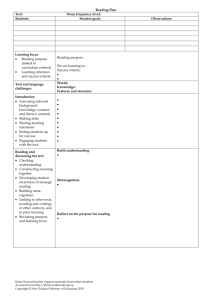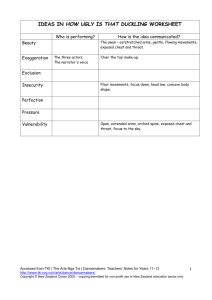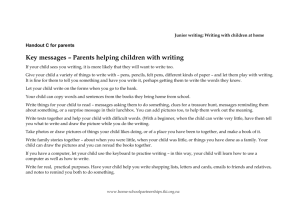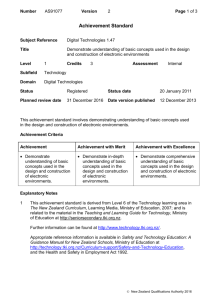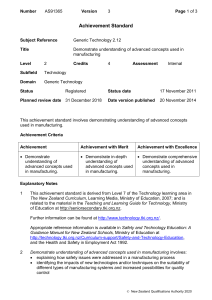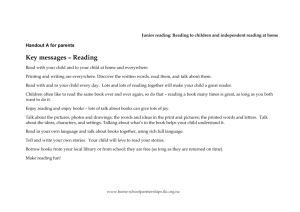You Can Count on It Connected L3 TSM - Literacy Online
advertisement
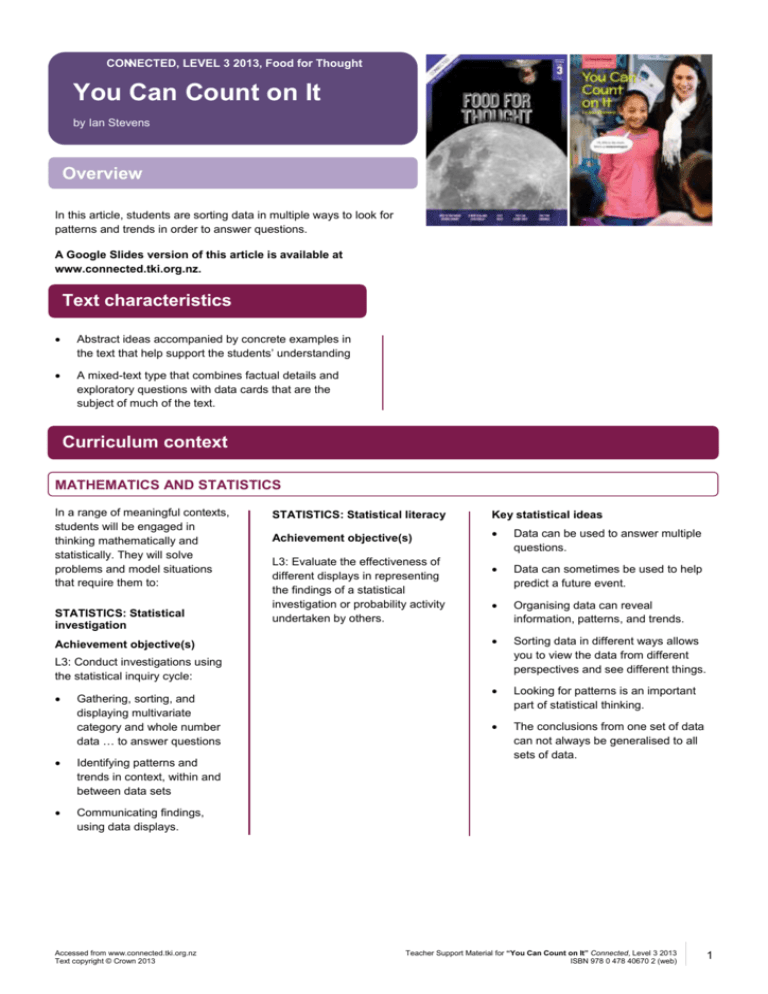
CONNECTED, LEVEL 3 2013, Food for Thought You Can Count on It by Ian Stevens Overview In this article, students are sorting data in multiple ways to look for patterns and trends in order to answer questions. A Google Slides version of this article is available at www.connected.tki.org.nz. Text characteristics Abstract ideas accompanied by concrete examples in the text that help support the students’ understanding A mixed-text type that combines factual details and exploratory questions with data cards that are the subject of much of the text. Curriculum context MATHEMATICS AND STATISTICS In a range of meaningful contexts, students will be engaged in thinking mathematically and statistically. They will solve problems and model situations that require them to: STATISTICS: Statistical investigation Achievement objective(s) STATISTICS: Statistical literacy Key statistical ideas Achievement objective(s) Data can be used to answer multiple questions. Data can sometimes be used to help predict a future event. Organising data can reveal information, patterns, and trends. Sorting data in different ways allows you to view the data from different perspectives and see different things. Looking for patterns is an important part of statistical thinking. The conclusions from one set of data can not always be generalised to all sets of data. L3: Evaluate the effectiveness of different displays in representing the findings of a statistical investigation or probability activity undertaken by others. L3: Conduct investigations using the statistical inquiry cycle: Gathering, sorting, and displaying multivariate category and whole number data … to answer questions Identifying patterns and trends in context, within and between data sets Communicating findings, using data displays. Accessed from www.connected.tki.org.nz Text copyright © Crown 2013 Teacher Support Material for “You Can Count on It” Connected, Level 3 2013 ISBN 978 0 478 40670 2 (web) 1 ENGLISH READING INDICATORS Ideas L3: Students will show a developing understanding of ideas within, across, and beyond texts. Uses their personal experience and world and literacy knowledge confidently to make meaning from texts. Makes meaning of increasingly complex texts by identifying main and subsidiary ideas in them. Starts to make connections by thinking about underlying ideas in and between texts. Makes and supports inferences from texts with increasing independence. THE LITERACY LEARNING PROGRESSIONS The literacy knowledge and skills that students need to draw on by the end of year 6 are described in The Literacy Learning Progressions. Meeting the literacy challenges The following strategies will support students to understand, respond to, and think critically about the information and ideas in the text. After reading the text, support students to explore the key statistical ideas outlined in the following pages. TEXT CHARACTERISTICS Abstract ideas, in greater numbers than in texts at earlier levels, accompanied by concrete examples in the text that help support the students’ understanding A mixed-text type that combines factual details and exploratory questions with data cards that are the subject of much of the text. Accessed from www.connected.tki.org.nz Text copyright © Crown 2013 TEACHER SUPPORT Want to know more about instructional strategies? Go to: http://literacyonline.tki.org.nz/Literacy-Online/Teacherneeds/Pedagogy/Reading#Years5-8 http://literacyonline.tki.org.nz/Literacy-Online/Studentneeds/National-Standards-Reading-and-Writing http://www.literacyprogressions.tki.org.nz/ “Working with Comprehension Strategies” (Chapter 5) from Teaching Reading Comprehension (Davis, 2007) gives comprehensive guidance for explicit strategy instruction in years 4–8. Teaching Reading Comprehension Strategies: A Practical Classroom Guide (Cameron, 2009) provides information, resources, and tools for comprehension strategy instruction. Teacher Support Material for “You Can Count on It” Connected, Level 3 2013 ISBN 978 0 478 40670 2 (web) 2 INSTRUCTIONAL STRATEGIES FINDING INFORMATION IN THE TEXT READING TABLES AND GRAPHS OF DATA ASK QUESTIONS to prompt the students to make connections between the title and the first paragraph. This text requires readers to repeatedly shift their focus from the text to the data cards. What is the connection between the title and the first paragraph? EXPLAIN that tables, graphs, or data cards contain crucial information. What helped you to make this connection? What could have helped you? Look at the illustration on page 19. DISCUSS how to read the information on a data card. MODEL the process of thinking aloud to show the students how to SCAN the headings and photographs to gain an overview of the text. The title refers to counting, so I know this will involve mathematics. The first heading invites me to imagine being a scientist, so I need to evaluate the information I read to see if it helps me understand how to be a scientist. There are photos of data cards and a heading says “Sorting data” and one saying “How do you know?”, so I infer that this is about using data cards to test predictions. ASK QUESTIONS to remind students of the vocabulary of graphs and how this relates to the data card graphs. PROMPT them to refer specifically to the x-axis (horizontal) or y-axis (vertical). What do we call the column on the left-hand side of the table? What does the data in the graph tell you? ASK QUESTIONS to help the students make connections to their prior knowledge and give them a purpose for reading: What do you know about collecting and sorting data? Has anyone seen a data card before? How can we use this article to help us learn more about how to use data? DISCUSS how to read the information on pages 20–22. How do you know where to read next? What is the difference between the information in the text boxes and the speech bubbles? How do the speech bubbles extend the information in the text boxes? EXPLAIN that the information on page 19 helps the reader to understand the job of a meteorologist/scientist who compares and analyses data. What are a meteorologist’s key tasks? Accessed from www.connected.tki.org.nz Text copyright © Crown 2013 Teacher Support Material for “You Can Count on It” Connected, Level 3 2013 ISBN 978 0 478 40670 2 (web) 3 Teacher support Imitating what real scientists, statisticians, and mathematicians do is a great learning opportunity for students when adapted to be at the students’ level. Gathering data is useful in revealing interesting information, patterns, and trends that can be used to answer questions or discover things. A data card displays multivariate data. This data card shows six pieces of information and allows something to be considered in relation to another thing. Statistical thinking is about investigating information or data to find new information. It is also about answering questions with several possible answers and thinking about how likely or how accurate each answer is. Sorting the data in different ways allows you to make sense of the information and find things. Data contains many facts and interesting information. Deciding whether the facts and information are useful in relation to the task set or question asked is a key part of statistical thinking. Resort the data cards to consider different things, investigate different relationships, and see patterns and trends. Communicating the findings is also a key part of statistical thinking. The data cards provide students with a way of showing their thinking, as well as providing evidence to back up their findings. Accessed from www.connected.tki.org.nz Text copyright © Crown 2013 Teacher Support Material for “You Can Count on It” Connected, Level 3 2013 ISBN 978 0 478 40670 2 (web) 4 Exploring the mathematics and statistics The following activities and suggestions are designed as a guide for supporting students to develop capabilities relating to gathering and interpreting data, statistical thinking, and problem solving. You are encouraged to adapt the activities to suit the specific needs of your students. LEARNING FOCUS KEY STATISTICAL IDEAS Students sort and re-sort in multiple ways to reveal information, interpret data, and discuss patterns and trends based on their observations. Key statistical ideas Data can be used to answer multiple questions. Data can sometimes be used to help predict a future event. Organising data can reveal information, patterns, and trends. Sorting data in different ways allows you to view the data from different perspectives and see different things. Looking for patterns is an important part of statistical thinking. The conclusions from one set of data can not always be generalised to all sets of data. LEARNING ACTIVITIES Activity 1: Investigating information using data cards Data cards are a great way of looking at information, and investigating and manipulating the data to find out and discover things. By moving around data cards students can “see” the information and explore one aspect of the information in relation to other aspects. To introduce data cards and to have your students work with data, make a class set of data cards. Select four pieces of information each student can write on to a data card about themselves, for example, height, gender, hand they write with, favourite colour, and so on. Collect the data cards and photocopy a set for each group of students to use. Encourage the groups of students to write a question or make a prediction. Sort the data cards to “see” if their prediction is correct or to answer their question. Then encourage the students to explore the data more by re-sorting the cards in multiple ways. Model how to make simple statements about what the data is saying. Students could test the validity of their findings by explaining them to others in a small group. Encourage them to ask each other critical questions focused on the central question in the same way professional scientists do. Finally, the class could discuss and compare their findings with the findings of the class in the Connected article. This activity could be repeated using: the same data squares as in this article data collected by the students from other students or family data downloaded from CensusAtSchool New Zealand data from other data sets (for example, from Statistics New Zealand). The statistics unit on the NZMaths website has more information about how to use data squares. Accessed from www.connected.tki.org.nz Text copyright © Crown 2013 Teacher Support Material for “You Can Count on It” Connected, Level 3 2013 ISBN 978 0 478 40670 2 (web) 5 Activity 2: Introducing the PPDAC cycle Introduce the PPDAC (Problem, Plan, Data, Analysis, Conclusion) cycle by downloading the “Are You a Data Detective?” poster from the CensusAtSchool New Zealand website. The students could map the five phases on to one of the investigations carried out by the students in the article. Groups could each choose a different investigation. Each group could present their “map” to the rest of the class for critique. Activity 3: Figure it out The Figure it Out books on statistics have activities that you can use to embed the students’ understandings of the use of data cards and to focus on other skills and understandings needed to conduct statistical inquiries. For example, the Level 3 book includes: collating, displaying, and interpreting data planning and conducting a survey using data cards exploring an issue and evaluating the findings. For example, the Level 3-4 book includes: collecting and analysing category data finding relationships between two variables finding patterns and relationships in a multivariate dataset. Activity 4: Whatever the weather Meteorologists like Fa΄aea’s mum use data to predict the weather (the atmospheric conditions over a short period of time). Making Better Sense of Planet Earth and Beyond includes a focus on weather that has activities to support student inquiry into weather features and patterns. Students learn to create and use tools with which to collect data on temperature, cloud cover, rainfall, and wind speed and direction. Activities 19 and 20 in Making Better Sense of Planet Earth and Beyond can be used to teach students how to read weather maps. When students have learnt this, they could look at sequences of weather maps over a series of days. Discuss the following questions: What patterns are there in the way the different features move and change? Do they always change in the same way? How does this affect weather prediction? How often is the forecast correct? Activity 5: Climate change? Discuss the relationship between weather and climate with your students. Research indicates that climate change has a significant effect on our planet. However, not everyone believes that climate change is real. Provide the students with the opportunity to draw their own conclusions by getting them to compare data, such as the average temperature over a large number of years, to look for trends and patterns. A good source for this is NIWA http://www.niwa.co.nz/education-and-training/schools/students/change#change1 Extension The students could try the “Green house effect in a jar” activity on the Climate Change New Zealand website. Google Slides version of “You Can Count it” www.connected.tki.org.nz Accessed from www.connected.tki.org.nz Text copyright © Crown 2013 Teacher Support Material for “You Can Count on It” Connected, Level 3 2013 ISBN 978 0 478 40670 2 (web) 6 RESOURCE LINKS Figure it Out – Statistics (revised edition) Level 3 http://www.nzmaths.co.nz/figure-it-out-carousel-interface#p=24 Levels 3–4 http://www.nzmaths.co.nz/figure-it-out-carousel-interface#p=36 NZMaths: Unit: “Data Squares Level 2” http://www.nzmaths.co.nz/resource/data-squares-level-2 Unit: “Data Squares Level 3” http://www.nzmaths.co.nz/resource/data-squares-level-3 CensusAtSchool New Zealand http://new.censusatschool.org.nz/resources/level-3/ Statistics New Zealand http://www.stats.govt.nz/browse_for_stats/education_and_training.aspx NASA: Climate and Climate Change http://www.nasa.gov/mission_pages/noaa-n/climate/index.html Climate Change Information New Zealand http://www.climatechange.govt.nz/ Accessed from www.connected.tki.org.nz Text copyright © Crown 2013 Teacher Support Material for “You Can Count on It” Connected, Level 3 2013 ISBN 978 0 478 40670 2 (web) 7
